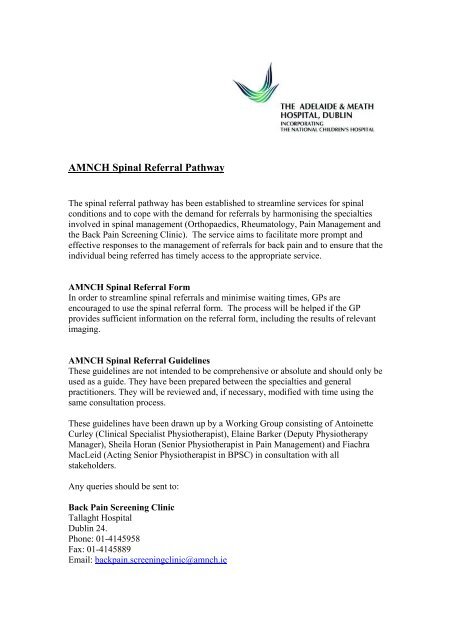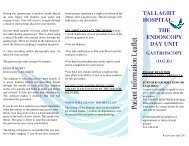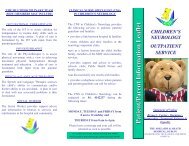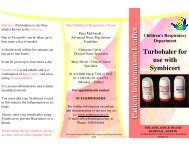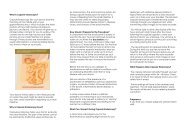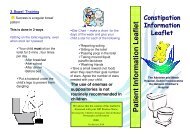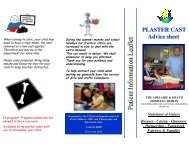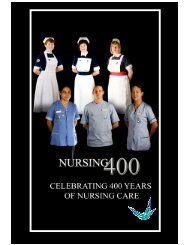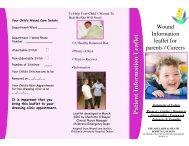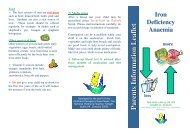AMNCH Spinal Referral Pathway
AMNCH Spinal Referral Pathway
AMNCH Spinal Referral Pathway
You also want an ePaper? Increase the reach of your titles
YUMPU automatically turns print PDFs into web optimized ePapers that Google loves.
<strong>AMNCH</strong> <strong>Spinal</strong> <strong>Referral</strong> <strong>Pathway</strong><br />
The spinal referral pathway has been established to streamline services for spinal<br />
conditions and to cope with the demand for referrals by harmonising the specialties<br />
involved in spinal management (Orthopaedics, Rheumatology, Pain Management and<br />
the Back Pain Screening Clinic). The service aims to facilitate more prompt and<br />
effective responses to the management of referrals for back pain and to ensure that the<br />
individual being referred has timely access to the appropriate service.<br />
<strong>AMNCH</strong> <strong>Spinal</strong> <strong>Referral</strong> Form<br />
In order to streamline spinal referrals and minimise waiting times, GPs are<br />
encouraged to use the spinal referral form. The process will be helped if the GP<br />
provides sufficient information on the referral form, including the results of relevant<br />
imaging.<br />
<strong>AMNCH</strong> <strong>Spinal</strong> <strong>Referral</strong> Guidelines<br />
These guidelines are not intended to be comprehensive or absolute and should only be<br />
used as a guide. They have been prepared between the specialties and general<br />
practitioners. They will be reviewed and, if necessary, modified with time using the<br />
same consultation process.<br />
These guidelines have been drawn up by a Working Group consisting of Antoinette<br />
Curley (Clinical Specialist Physiotherapist), Elaine Barker (Deputy Physiotherapy<br />
Manager), Sheila Horan (Senior Physiotherapist in Pain Management) and Fiachra<br />
MacLeid (Acting Senior Physiotherapist in BPSC) in consultation with all<br />
stakeholders.<br />
Any queries should be sent to:<br />
Back Pain Screening Clinic<br />
Tallaght Hospital<br />
Dublin 24.<br />
Phone: 01-4145958<br />
Fax: 01-4145889<br />
Email: backpain.screeningclinic@amnch.ie
Table of Contents Page<br />
1.0 Departments Involved in <strong>Spinal</strong> <strong>Referral</strong> <strong>Pathway</strong> 2<br />
2.0 Back Pain Diagnostic Imaging Criteria 3<br />
3.0 Back Pain Pharmacological Management 4<br />
4.0 <strong>Referral</strong> and Priority Guidelines 5<br />
The Adelaide and Meath Hospital, Dublin Incorporating the National Children’s Hospital (<strong>AMNCH</strong>)<br />
<strong>Spinal</strong> <strong>Referral</strong> Guidelines January 2012<br />
1
1.0 Departments involved in <strong>Spinal</strong> <strong>Referral</strong> <strong>Pathway</strong><br />
Below is a list of the departments involved in the spinal referral pathway along with<br />
the clinicians/consultants involved.<br />
Back Pain Screening Clinic (BPSC)<br />
The BPSC is a screening clinic for spinal pain. Its purpose is to fast-track potential<br />
surgical cases and suspected serious spinal pathology to the <strong>Spinal</strong> Orthopaedic<br />
Clinics.<br />
The patient is triaged by a Physiotherapist and management options include advice<br />
and referral for surgical review. Information leaflets, which include the telephone<br />
numbers, are available for GPs to give to their patients.<br />
All patients with acute back and neck pain that are not requiring immediate referral to<br />
the Emergency Department (as per page 5) should be directed through BPSC.<br />
Physiotherapists<br />
Antoinette Curley<br />
Cliodhna Kelleher<br />
Fiachra MacLeid<br />
Department of Orthopaedics<br />
The department of orthopaedics provides a service for patients with spinal deformity<br />
and Spina Bifida. All referrals should be directed to the BPSC and will be forwarded<br />
to the department of orthopaedics accordingly.<br />
Consultant<br />
Mr. Patrick Kiely<br />
Mr. David Moore<br />
Mr. Seamus Morris<br />
Mr. Jacques Noel<br />
Mr. Joseph Sparkes<br />
Department of Rheumatology<br />
The department of rheumatology provides a spinal service to patients with<br />
rheumatological conditions such as sacroiliitis or spondyloarthrpathy (e.g. Ankylosing<br />
Spondylitis). Your patient may be asked to attend for blood tests or x-rays in advance<br />
of their appointment so that these results will be available on the day of their<br />
appointment.<br />
Consultant<br />
Prof. David Kane<br />
The Adelaide and Meath Hospital, Dublin Incorporating the National Children’s Hospital (<strong>AMNCH</strong>)<br />
<strong>Spinal</strong> <strong>Referral</strong> Guidelines January 2012<br />
2
Department of Anaesthesia & Pain Medicine<br />
The Pain Service is a multidisciplinary service for management of acute and chronic<br />
pain. The service is staffed by 3 Pain Specialist Consultants, 3 Nurses, a Senior<br />
Physiotherapist, Senior Clinical Psychologist and a Senior Occupational Therapist.<br />
There is a dedicated referral route to Liaison Psychiatry. Pain management options<br />
may include medication trials, interventional techniques, referral to psychiatry,<br />
psychology or physiotherapy treatment. This service offers a multidisciplinary Pain<br />
Management Programme – The Ulysses Programme. This is a four week cognitive<br />
behavioural programme which aims to treat the whole person by addressing the<br />
psychological, social and physical consequences of chronic pain.<br />
Consultant<br />
Dr Camillus Power<br />
Dr Philip Hu<br />
Dr. Anne Heffernan<br />
The Adelaide and Meath Hospital, Dublin Incorporating the National Children’s Hospital (<strong>AMNCH</strong>)<br />
<strong>Spinal</strong> <strong>Referral</strong> Guidelines January 2012<br />
3
2.0 Back Pain Diagnostic Imaging Criteria<br />
Criteria for Lumbar Spine Radiographs<br />
Plain films of the lumbar spine are not routinely indicated in the investigation of<br />
uncomplicated low back pain. This resolves in about 90% of patients within 2 months<br />
regardless of any treatment.<br />
Lumbar spine series should be reserved for selected cases including:<br />
• Significant trauma (e.g. RTA, fall from height)<br />
• Age 50<br />
• Associated fever/systemic symptoms (Anaemia, ^ESR)<br />
• Known background malignancy or previous spinal infection<br />
• Known background of osteoporosis<br />
• Episode of back pain ongoing for 6 weeks or longer without improvement<br />
• Chronic corticosteroid use, alcohol or drug abuse<br />
• Associated neurological deficit<br />
• History of Ankylosing Spondylitis<br />
Source: US Dept. of Health, Royal College of Radiologists<br />
Criteria for MRI<br />
Same day investigation for suspected cord compression/cauda equina syndrome<br />
• More than 6 week history with radiculopathy unresponsive to conservative<br />
therapy. Clinico-radiological correlation essential as asymptomatic disc<br />
herniations frequently seen on MRI<br />
• Suspected recurrent disc in post-operative spine<br />
• Suspected discitis, osteomyelitis, epidural abscess<br />
• Useful for primary and secondary malignancy in the spine<br />
The Adelaide and Meath Hospital, Dublin Incorporating the National Children’s Hospital (<strong>AMNCH</strong>)<br />
<strong>Spinal</strong> <strong>Referral</strong> Guidelines January 2012<br />
4
3.0 Back Pain Pharmacological Management<br />
Management of Acute Low Back Pain (without radiculopathy)<br />
• For first-line analgesia, offer Paracetamol.<br />
• If paracetamol is insufficient, offer an NSAID<br />
Consider the risk of adverse effects, especially in older people, those at<br />
increased risk of gastrointestinal adverse effects, or those with asthma,<br />
chronic kidney disease or heart conditions.<br />
Prescribe a proton-pump inhibitor for patients at increased risk of<br />
gastrointestinal bleeding.<br />
Review NSAID treatment if patient develops dyspepsia.<br />
In patients at risk of cardiovascular adverse effects, ibuprofen (up to<br />
1.2g/ day) or naproxen (up to 1g/ day) are recommended as 1 st -line<br />
options.<br />
For additional analgesia, consider the following options:<br />
• Paracetamol combined with NSAID<br />
• Adding Weak Opioid such as tramadol, or codeine (included in paracetamolcodeine<br />
combination products such as Tylex ® )<br />
Give due consideration to risk of opioid dependence and adverse<br />
effects<br />
Consider the need for a laxative to counteracting constipating effects<br />
• Strong Opioid- this is rarely necessary. If a strong opioid (such as standardrelease<br />
morphine) is to be used:<br />
Prescribe it for a short period, and step down to a weak opioid when<br />
appropriate<br />
Co-prescribe a laxative and anti-emetic<br />
If the use of a strong opioid is becoming chronic, or if doses are<br />
escalating, refer to, or seek advice from the clinic.<br />
• Consider offering short course of benzodiazepine, such as diazepam for 2-5<br />
days, if the paraspinal muscles are in spasm.<br />
• If symptoms continue for more than 4-6 weeks, manage as for chronic low<br />
back pain.<br />
Management of Chronic Low Back Pain (without radiculopathy)<br />
For chronic back pain not responding to the first-line analgesia and additional<br />
analgesics recommended above for acute low back pain:<br />
• Consider offering a trial of a tricyclic antidepressant such as amitriptylline,<br />
nortriptylline, or impramine<br />
Start at a low dosage, particularly in the elderly or frail, and increase<br />
up to the maximum antidepressant dosage until either pain is<br />
adequately relieved or adverse effects are unacceptable<br />
• Strong opioid- this is rarely necessary; see above re prescribing<br />
recommendations<br />
Management of Sciatica (lumbar radiculopathy)<br />
For sciatica not responding to first-line analgesia and additional analgesics<br />
recommended for acute low back pain:<br />
• Consider offering pregabalin or gabapentin or amitriptyline for initial<br />
treatment<br />
Titrate dosage according to response and tolerability<br />
The Adelaide and Meath Hospital, Dublin Incorporating the National Children’s Hospital (<strong>AMNCH</strong>)<br />
<strong>Spinal</strong> <strong>Referral</strong> Guidelines January 2012<br />
5
Consider imipramine or nortriptyline if amitriptyline is effective but<br />
the person cannot tolerate the adverse effects<br />
Continue the treatment if there is satisfactory pain improvement or<br />
refer if appropriate<br />
Consider gradually reducing the dose over time if improvement is<br />
sustained.<br />
Management of Neuropathic Pain (other than diabetic or trigeminal neuropathy)<br />
• Offer amitriptyline or pregabalin or gabapentin<br />
Titrate dosage according to response and tolerability<br />
Consider impiramine or nortriptyline if amitriptyline is effective but<br />
the person cannot tolerate the adverse effects<br />
Continue the treatment if there is satisfactory pain improvement or<br />
refer if appropriate<br />
Consider gradually reducing the dose over time if improvement is<br />
sustained.<br />
• For patients who do not achieve satisfactory pain reduction at the maximum<br />
tolerated dose:<br />
If on amitriptyline or another tricyclic antidepressant, switch to<br />
pregabalin or gabapentin, or combine the tricyclic antidepressant<br />
with either pregabalin or gabapenin<br />
If on pregabalin or gabapentin, switch to amitriptyline (or another<br />
tricyclic antidepressant, see above) or combine pregabalin or<br />
gabapentin with the tricyclic antidepressant<br />
• If the person still fails to achieve satisfactory pain reduction with drug<br />
treatment at the maximum tolerated dose:<br />
Refer to the clinic, stating the medications, doses and time-periods that<br />
have been tried.<br />
While awaiting referral:<br />
Consider a trial of tramadol, alone or in combination with<br />
amitriptyline and/ or pregabalin/ gabapentin. When used in<br />
combination therapy, tramadol should be prescribed as a rescue<br />
analgesic for breakthrough pain.<br />
Consider topical lidocaine for treatment of localized pain for<br />
people unable to take oral mediation because of medical conditions<br />
or disability.<br />
The Adelaide and Meath Hospital, Dublin Incorporating the National Children’s Hospital (<strong>AMNCH</strong>)<br />
<strong>Spinal</strong> <strong>Referral</strong> Guidelines January 2012<br />
6
Tricyclic<br />
antidepressant<br />
Opioid<br />
analgesia<br />
Drug Dose Notes<br />
Amitriptyline Start with 10mg at night. Amitriptyline 10mg tablets<br />
Imipramine<br />
Increase gradually to 75mg if<br />
tolerated (higher doses under<br />
unlicensed* in Ireland; 25mg<br />
tablets licensed but not for this<br />
Nortriptyline<br />
specialist supervision)<br />
indication and not suitable for<br />
halving.<br />
Imipramine and nortriptyline<br />
tablets unlicensed* in Ireland<br />
6-8 week trial (if tolerated) with<br />
at least 2 weeks<br />
Gabapentin 300mg at night increased by Most patients respond at 1.2g<br />
300mg every 2-3 days based on daily or more. Gabapentin can be<br />
response, to a usual total very sedating initially. Response<br />
maximum dose of 1800mg daily often seen within a few days but<br />
in 3 divided doses<br />
peak effect after a few weeks.<br />
Dose reduction in renal<br />
impairment<br />
Pregabalin Initially 75mg twice daily. Dose Dose reduction in renal<br />
may be increased to 150mg twice impairment.<br />
daily after an interval of 3-7 days Some consultants suggest using<br />
and further increased to 300mg lower initial doses, particularly in<br />
twice daily after an additional 7 older patients e.g., 25mg twice<br />
days if required<br />
daily<br />
Topical One patch daily for a maximum If no response after 2–4 weeks,<br />
lidocaine 5% of 12 hours; can use up to three discontinue treatment. Unlicensed<br />
patch patches at a time<br />
in Ireland*<br />
Tramadol 50mg once or twice daily;<br />
increase by 50-100mg/ day in<br />
divided doses every 3-7 days as<br />
tolerated to a maximum dose of<br />
400mg/day (as 100mg QDS), or<br />
a maximum of 300mg/ day in<br />
patients over 65 years<br />
*Note: unlicensed medicines must be sourced by community pharmacy and are not<br />
reimbursed under the Government Drug Payment Schemes; therefore patients may have<br />
to pay for these medicines themselves.<br />
Please refer to the BNF and/ or SPC for full prescribing information on individual<br />
products.<br />
References<br />
• <strong>AMNCH</strong> Adult Medicines Guide 2011/2012<br />
• British National Formulary 62 nd edition. September 2011<br />
• Clinical Knowledge Summaries (CKS). CKS topic review: Low back pain. November<br />
2009. Available online at http://www.cks.nhs.uk/back_pain_low_without_radiculopathy<br />
• Clinical Knowledge Summaries (CKS). CKS topic review: Sciatica (lumbar<br />
radiculopathy). November 2009. Available online at<br />
http://www.cks.nhs.uk/sciatica_lumbar_radiculopathy<br />
• CKS topic review: Neuropathic pain Source: Clinical Knowledge Summaries (CKS), Last<br />
revised September 2010. Available online at<br />
http://www.cks.nhs.uk/neuropathic_pain_drug_treatment<br />
The Adelaide and Meath Hospital, Dublin Incorporating the National Children’s Hospital (<strong>AMNCH</strong>)<br />
<strong>Spinal</strong> <strong>Referral</strong> Guidelines January 2012<br />
7
4.0 <strong>Referral</strong> and Priority Guidelines<br />
These guidelines are for GPs referring patients with spinal disorders for a specialist<br />
opinion. They are not expected to cover all eventualities and clinical judgement<br />
should apply. They are provided for information purposes and indicate which<br />
conditions will be referred on to each speciality. It is requested that sufficient clinical<br />
information is provided by GPs to facilitate the process.<br />
The guidelines indicate which patients should be referred to the Emergency<br />
Department for ‘immediate’ review. All other patients with acute back and neck pain<br />
that do not require immediate referral should be directed through BPSC. These<br />
‘urgent’ and ‘routine’ patients will then be reviewed by the most appropriate service.<br />
IMMEDIATE REFERRAL<br />
<strong>Referral</strong> direct to Emergency Department (ED).<br />
Condition<br />
Cauda Equina Syndrome: Sphincter disturbance, Gait disturbance<br />
ED<br />
or saddle anaesthesia<br />
√<br />
Suspected traumatic fracture √<br />
<strong>Spinal</strong> infection √<br />
URGENT REFERRAL<br />
<strong>Referral</strong> via <strong>Spinal</strong> <strong>Referral</strong> Form faxed to 01-4145866.<br />
Patient should be seen within 4 weeks.<br />
Condition BPSC Ortho Rheum Pain<br />
Past history of carcinoma, steroid use or HIV √<br />
Unwell or weight loss √<br />
Widespread neurology √<br />
Thoracic pain √<br />
Non mechanical back pain √<br />
<strong>Spinal</strong> deformity √<br />
Back pain with neurological symptoms<br />
Back pain/stiffness with raised ESR/CRP<br />
√<br />
where acute infection is out ruled/not a<br />
√<br />
concern (i.e. longstanding)<br />
Osteoporotic vertebral collapse<br />
Patient with established RA or CTD with<br />
acute swollen joint/rashes/eye/respiratory/<br />
neurological/gastrointestinal symptoms<br />
√<br />
Congenital spinal deformity/Spina<br />
√<br />
Bifida/Cerebral Palsy<br />
Solid musculoskeletal-related lumps √<br />
Back pain secondary to cancer √<br />
The Adelaide and Meath Hospital, Dublin Incorporating the National Children’s Hospital (<strong>AMNCH</strong>)<br />
<strong>Spinal</strong> <strong>Referral</strong> Guidelines January 2012<br />
√<br />
8
ROUTINE REFERRAL<br />
<strong>Referral</strong> via <strong>Spinal</strong> <strong>Referral</strong> Form faxed to 01-4145866.<br />
Condition<br />
Mechanical Back/Neck Pain lasting > 6-8<br />
BPSC Ortho Rheum Pain<br />
weeks & with no improvement in symptoms<br />
following a course of appropriate physiotherapy<br />
√<br />
(*see below)<br />
Nerve Root Pain without neurological<br />
weakness with no improvement after 4-6<br />
weeks (**see below)<br />
Disc Prolapse √<br />
Sacro-Iliac Joint (SIJ) Pain √<br />
<strong>Spinal</strong> Stenosis (Lateral/Central) √<br />
Lumbar/Cervical Facet joint pain √<br />
Paget’s disease or other bone disease √<br />
Metabolic arthropathy √<br />
Sacroilitis/Inflammatory <strong>Spinal</strong> Pathology √<br />
Post surgery failed back syndrome<br />
Chronic back pain with no<br />
√<br />
neurological abnormalities/ structural<br />
damage or systemic illness & having failed a<br />
course of appropriate physiotherapy<br />
√<br />
*Mechanical Back/Neck Pain lasting > 6- 8 weeks & with no improvement in symptoms<br />
following a course of appropriate physiotherapy<br />
• Presentation:<br />
o 18-55 years<br />
o Mechanical type pain (varies with posture and activity usually<br />
better when lies down flat)<br />
o Pain in lower back, buttock or posterior thigh<br />
o Patient otherwise well<br />
• These patients can be initially managed in primary care and referral to primary care<br />
physiotherapy (where available) is recommended.<br />
• These patients should be referred to BPSC after 6-8 weeks in instances of<br />
o Problems with pain control or<br />
o No improvement in symptoms despite a course of appropriate physiotherapy.<br />
**Nerve root pain without neurological weakness with no improvement after 4-6 weeks<br />
• Presentation:<br />
o Unilateral leg/arm pain that is worse than back/neck pain<br />
o Radiates below knee/elbow<br />
o Numbness or paraesthesia in same distribution<br />
o Straight Leg Raise increases leg pain<br />
• These patients should be referred to BPSC if no improvement after 4-6 weeks<br />
The Adelaide and Meath Hospital, Dublin Incorporating the National Children’s Hospital (<strong>AMNCH</strong>)<br />
<strong>Spinal</strong> <strong>Referral</strong> Guidelines January 2012<br />
√<br />
9


